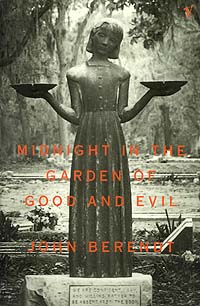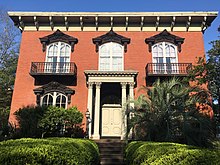Midnight in the Garden of Good and Evil
 The cover of the 1994 book, which features the Bird Girl sculpture. | |
| Author | John Berendt |
|---|---|
| Country | United States |
| Language | English |
| Genre | Non-fiction novel |
| Publisher | Random House |
Publication date | January 1994 |
| Media type | Print (hardback and paperback) |
| Pages | 389 |
| ISBN | 0-679-42922-0 |
| OCLC | 27975809 |
| 975.8/724 20 | |
| LC Class | F294.S2 B48 1994 |
Midnight in the Garden of Good and Evil is a non-fiction novel by John Berendt. The book, Berendt's first, was published in 1994 and follows the story of Jim Williams, an antiques dealer on trial for the shooting death of Danny Hansford. Subtitled A Savannah Story, with an initial printing of 25,000 copies,[1] the book became a New York Times Best-Seller for 216 weeks following its debut and remains one of the longest-standing New York Times Best-Sellers.[2]
Berendt combined self-witnessed experiences during his time living in Savannah (roughly four years after the shooting) with stories from the preceding years recounted to him by locals; he catches up with proceedings around the book's mid-point. Williams was a free man during Berendt's five years in Savannah. The author, who created the fictional author John Kelso to represent himself, took some liberties with his writing, including creating a relationship between Joe Odom and Nancy Hillis. Furthermore, Odom died over two years before the book's publication.
The character Serena Dawes was based on silent-film actress and heiress Helen Avis Drexel, while voodoo priestess Valerie Boles was the inspiration for Minerva.
The book was adapted for Clint Eastwood's 1997 film, with several characters' names changed to protect their privacy.
Background[edit]
In tone, Midnight in the Garden of Good and Evil is atmospherically Deep South coastal (Savannah, Georgia, and Beaufort, South Carolina) and Southern Gothic, depicting a wide range of eccentric personalities in and around Savannah.
The central narrative concerns the shooting of Danny Hansford, a local male prostitute, characterized as "a good time not yet had by all" by Prentiss Crowe, a Savannah socialite. The perpetrator was respected antiques dealer Jim Williams, who was also his employer and casual sexual partner. Hansford's death resulted in four murder trials, with the final one ending in acquittal after the judge finally agreed to a change of venue to move the case away from the Savannah jury pool. The book describes Williams' version of the killing, which is that it was in "self-defense"—the result of Hansford, who was prone to fits of rage, shooting at Williams with a gun that was on display, and Williams shooting back to protect himself—and not murder, pre-meditated or otherwise, by Williams. The death occurred in Williams' Mercer House home, the ground floor of which is now a museum.[1]
The book highlights many other notable Savannah residents, including The Lady Chablis, a local transgender woman, club performer, and entertainer. Chablis provides both a Greek chorus of sorts as well as a light-hearted contrast to the more serious action. Chablis was given a dedicated chapter, as was Emma Kelly, the "lady of 6,000 songs.”[1]
Characters and events[edit]
The book's plot is based on real-life events that occurred in the 1980s and is classified as non-fiction. Because it reads like a novel (and rearranges the sequence of true events in time), it is sometimes referred to as a "non-fiction novel."

Although the book's timeline is set to coincide with the entire saga of Jim Williams' arrest and four trials for murder, in reality Berendt did not meet Williams for the first time until 1982 — after the millionaire had been convicted of murder and released pending appeal. Berendt also did not move to Savannah to collect material for his book until 1985 — after Williams' second conviction. Williams was a free man and living in Mercer House during Berendt's five years in Savannah.[1]
"The only fictional character in the book is the narrator, me, until I catch up with myself midway through the book," Berendt said in 1995. "I felt that was a legitimate license to take. The book is 99 percent true and 1 percent exaggeration."[3]
In the first chapter, Berendt and Williams are interrupted by Hansford's screaming entrance; this happened prior to Williams and Berendt's meeting. "Jim was having drinks with somebody else," explains Berendt. "Jim told me about it and so did somebody else. So I reconstructed it, put myself in there. The first evening in Mercer House is a combination of a lot of stories he told me. Then afterward, I meet all these people — Joe Odom, Chablis, Lee Adler. I met all these people, obviously, after the murder, but they don't impact the murder at all, so I simply put them right after my meeting with Jim, and it seems as though I met them before the shooting and I didn't, but so what? All of those meetings with people were actual meetings. They took place in '85 or later, and they are pretty much verbatim what happened with those people and me."[1]
Nancy Hillis, who appears as Mandy Nichols, later explained that, contrary to Berendt's portrayal of her, she did not meet Joe Odom until he had moved from 16 East Jones Street to 101 East Oglethorpe Avenue. She also clarified that there was no romantic relationship between her and Odom, largely because Odom was gay. Odom died in 1991, over two years before the book was published, but this is not mentioned in its narrative.[1]
The person represented by Serena Dawes (a composite character of Helen Avis Drexel)[4] died in 1974, over twenty years before the book's release.[1]
Minerva is based on Valerie Boles, a root doctor from South Carolina.[5]
Title[edit]
The title alludes to the hoodoo notion of "midnight," the period between the time for good magic (11:30 P.M. to midnight) and the time for evil magic (midnight to 12:30 A.M.).[1]
Although Bonaventure Cemetery is the focus in the book, "the garden of good and evil" refers principally to the cemetery off Congress Street in Beaufort, South Carolina,[6] where Dr. Louis Buzzard, the husband of Minerva, the folk-magic practitioner who figures in the story, is buried. It is over his grave that Minerva performed the incantations to ensure a more successful result in the retrial for the case of Jim Williams. (The marriage between Minerva and Dr. Buzzard was the invention of John Berendt. Dr. Buzzard was based on Stephen Robinson, who died in 1947, aged 61 or 62.)[7]
Cover[edit]
The Bird Girl statue, designed both as art and as a birdseed holder, was originally located at Savannah's historic Bonaventure Cemetery. A Savannah photographer, Jack Leigh, was commissioned to take a photograph for the cover of the book. The cover image became immediately iconic, with author John Berendt calling it "one of the strongest covers I've ever seen", and the statue became a popular stop for tourists. Owing to rising concerns about the integrity of the statue and the cemetery's privacy, Bird Girl was relocated in 1997 for display in Telfair Museums in Savannah.
Legacy[edit]
In 1993, the year before the book's publication, Savannah had five million visitors,[8] who spent almost $600 million during their time in the city.[9] Two years after the book's release, Savannah was seeing a 46% increase in tourism.[1] Twenty years later, the number of visitors to the city had jumped to 12.5 million, spending $2.2 billion.[9] Joseph Marinelli, president of the Savannah Convention and Visitors Bureau, does not attribute the city's popularity growth entirely to Midnight, but that it had a significant impact.[10]
Awards[edit]
The book won the 1995 Boeke Prize and was one of the finalists for the 1995 Pulitzer Prize for non-fiction.[11]
Audiobook[edit]
Jeff Woodman recorded the audiobook version of Midnight in the Garden of Good and Evil. He stated that Berendt's effort, along with that of Ellen Raskin's The Westing Game, was the most challenging to record: "Especially because all the characters in Midnight have the same damned Savannah accent, so you can't toss in a little North Country to help differentiate them!" he said in 2010.[12]
References[edit]
- ^ a b c d e f g h i "MIDNIGHT IN THE GARDEN OF FACT AND FICTION" - Washington Examiner, December 29, 1996
- ^ "Midnight in the Garden of Good and Evil". New Georgia Encyclopedia. Archived from the original on 2008-09-29. Retrieved 2008-01-14.
- ^ "'Evil' yields plenty of good Read on: Author John Berendt and Savannah, Ga., are basking in the success of his best seller". Baltimore Sun. 27 November 1995. Retrieved 2022-04-23.
- ^ "The Museum Next Door". Garden & Gun. Retrieved 2022-03-25.
- ^ “Reclusive voodoo priestess of ‘Midnight’ fame dies” - Savannah Morning News, May 8, 2009
- ^ "Oct 26, 1994, page 41 - The Atlanta Constitution at Atlanta Journal Constitution". Newspapers.com. Retrieved 2024-03-28.
- ^ "Voodoo’s heyday has passed, but the Gullah tradition still bewitches in SC" - The State, January 27, 2016
- ^ "The impact of 'Midnight in the Garden of Good and Evil' on Savannah over 30 years". WKU Public Radio | The Public Radio Service of Western Kentucky University. 2024-01-12. Retrieved 2024-03-28.
- ^ a b "20 Years After Midnight: A Look Back" - South magazine, October 7, 2017
- ^ "The impact of 'Midnight in the Garden of Good and Evil' on Savannah over 30 years". WKU Public Radio | The Public Radio Service of Western Kentucky University. 2024-01-12. Retrieved 2024-03-28.
- ^ Jan Whitt (28 August 2008). Settling the borderland: other voices in literary journalism. University Press of America. p. 53. ISBN 978-0-7618-4093-0. Retrieved 12 September 2010.
- ^ Forbus, Jen. "Audio Book Thursday: Narrator Jeff Woodman". Retrieved 2023-12-30.
External links[edit]
- "Photos of the first edition of Midnight in the Garden of Good and Evil". Mansion Books.
- "Booknotes interview with Berendt on Midnight". C-SPAN. August 1997.
- "Official book site". RandomHouse.com.
